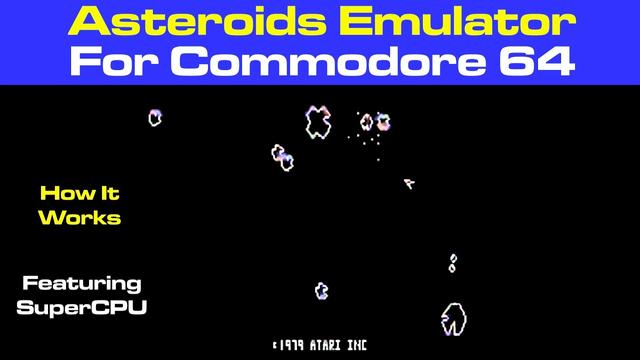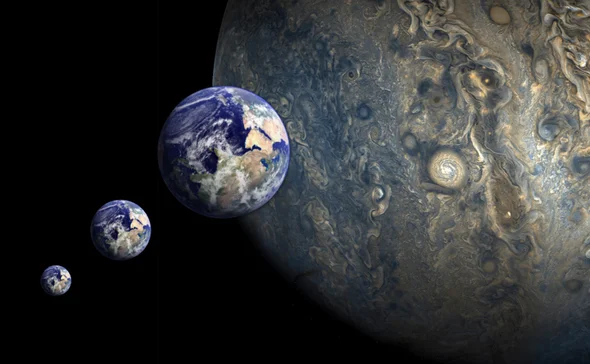#C64 #Asteroids #RetroGaming #SuperCPU #Emulation
https://theoasisbbs.com/asteroids-arcade-emulator-on-c64/?feed_id=4706&_unique_id=6894a628ba439
#QuizOfTheDay: #Moons, also known as natural #Satellites, orbit #Planets and #Asteroids in our #SolarSystem. Earth has one moon, and there are more than 200 moons in our solar system.
Do you know Phobos is a moon of which planet?
A. Mars
B. Jupiter
C. Saturn
D. Uranus
https://knowledgezone.co.in/resources/quiz?qId=6277757d5fa97eea95734d0a
#vectrex #asteroids
Q: Is it Possible 2024 YR4 Could Impact the Moon?
A: Asteroid 2024 YR4 has a very small chance of impacting the Moon on Dec. 22, 2032. If the asteroid were to impact the Moon, it would not alter its orbit.
Q: Is it Possible to Deflect Asteroid 2024 YR4? Could We Use a Spacecraft Similar to DART?
A: A kinetic impactor spacecraft like NASA’s Double Asteroid Redirection Test (DART) mission is one asteroid deflection technique that could be used to address a potentially hazardous asteroid in the future. Each asteroid is unique, and deflection would depend on the asteroid’s size, physical properties, orbit, and discovery warning time. 2024 YR4 poses no significant impact risk to the planet, and thus it is premature to speculate on potential deflection techniques for this asteroid.
"Let's look at what happened back then:"
Collision at Asteroid Dimorphos
Video Credit: ASI NASA, Johns Hopkins APL, DART, LICIACube, LUKE, IOP
Explanation:
Why was this collision so strange? In 2022, to develop Earth-saving technology, NASA deliberately crashed the DART spacecraft into the asteroid moonlet Dimorphos. The hope was that this collision would alter the trajectory of Dimorphos around its parent asteroid Didymos and so demonstrate that similar collisions could, in theory, save the Earth from being hit by (other) hazardous asteroids. But analyses of new results show that the effects of the collision are different than expected -- and we are trying to understand why. Featured here is the time lapse video taken by the ejected LICIACube camera LUKE showing about 250 seconds of the expanding debris field of Dimorphos after the collision, with un-impacted Didymos passing in the foreground. In 2026, Europe's Hera mission will reach the asteroids and release three spacecraft to better study the matter.
https://apod.nasa.gov/apod/ap250728.html
#space #asteroids #astrophotography #photography #science #astronomy #tech #security #defense #NASA #ESA
For all those who would like to see the position of the asteroid in space as an interactive 3D model, here is the direct link to the app:
https://eyes.nasa.gov/apps/asteroids/#/2024_yr4
#space #asteroids #astrophotography #photography #science #astronomy #tech #security #defense #NASA #ESA
2024 YR4 Facts
NASA Science Editorial Team
Asteroid 2024 YR4 is a near-Earth asteroid, meaning it is an asteroid in an orbit that brings it into Earth’s region of the solar system. When it was first discovered, it appeared to have a very small chance to impact Earth on Dec. 22, 2032. As observations of 2024 YR4 continued through early 2025, NASA concluded the object poses no significant impact risk to Earth in 2032 and beyond.
New infrared observations from NASA’s James Webb Space Telescope have decreased the uncertainty of the asteroid’s size, and 2024 YR4 is now estimated to be 174-220 feet (53-67 meters), about the size of a 15-story building. The previous size estimate of 131-295 feet (40-90 meters) was derived from visible light measurements from ground-based telescopes.
This object is of particular interest for planetary defense for two reasons:
1)
it is large enough to cause localized damage in the unlikely event that it should impact Earth, and
2)
it surpassed the 1% impact probability threshold to warrant formal notification of the object to other U.S. government agencies involved in planetary defense as well as to the Space Mission Planning Advisory Group and to the United Nations Office of Outer Space Affairs per the International Asteroid Warning Network’s notification charter.
As more observations of the asteroid’s orbit were obtained, its impact probability became better known and enabled planetary defense experts to determine it poses no significant risk to the planet.
[...]
https://science.nasa.gov/solar-system/asteroids/2024-yr4-facts/
FAQ's discussed in this Video:
+ What are the chances it’ll hit Earth?
+ Why do those odds keep changing?
+ And should you be worried?
Producers: Scott Bednar, Jessie Wilde, Pedro Cota
https://science.nasa.gov/solar-system/asteroids/2024-yr4/
#space #asteroids #astrophotography #photography #science #astronomy #tech #security #defense #NASA #ESA
Planetary Defense at NASA
In 2016, NASA established the Planetary Defense Coordination Office (PDCO) to manage the agency's ongoing mission of finding, tracking, and better understanding asteroids and comets that could pose an impact hazard to Earth. Here you can stay informed about the PDCO, NASA's Near-Earth Object (NEO) Observations Program, and upcoming planetary defense flight missions, including NASA'S NEO Surveyor mission.
Planetary Defenders
NASA’s Planetary Defenders is a gripping documentary that delves into the high-stakes world of asteroid detection and planetary defense by journeying alongside NASA’s dedicated team of scientists, astronomers, and engineers who discover, track, and monitor near-Earth asteroids to safeguard Earth from potential impacts. Available now on NASA+ and other streaming platforms.
How would humanity respond if we discovered an asteroid headed for Earth? NASA’s "Planetary Defenders" is a gripping documentary that delves into the high-stakes world of asteroid detection and planetary defense.
Short video version
https://science.nasa.gov/planetary-defense/
Full documentary 1:15:03
https://science.nasa.gov/science-research/planetary-science/planetary-defense/planetary-defenders/
#space #asteroids #astrophotography #photography #science #astronomy #tech #security #defense #NASA #ESA
June 30, 2017
NASA Planetary Defense:
Backyard Asteroid Observer
Backyard astronomer Robert Holmes of Westfield, Illinois, is part of NASA's army of observers scanning the night sky for asteroids.
"We do follow-up observations with NASA's near-Earth observations program. All night long, I'm running big telescopes. One's a 24-inch, a 30-inch, and a 32-inch. And then the 50 inch is my… my biggest telescope [...]."
"[...] We do follow-up observations for the discoveries that are made by the large sky surveys. By looking at these asteroids, and measuring these asteroids, we can determine what their possibilities of actually hitting the Earth in the future are going to be.
NASA provides coordinates of specific objects that they need observations on. I'm gonna punch in the coordinates here, and I'm doing this remotely from inside a control room, not at the telescope. And so, we look these objects up and then use those coordinates to look at a tiny piece of the sky that this object happens to be in. And then we follow those objects, and define and refine orbits for those objects, and reduce the uncertainty of where it's going to go in the near future.
I started off as a volunteer in 2006. It's just blossomed into a full-time opportunity to work for NASA under their grant program, where I'm now doing this every single clear night.
Now we're starting the observing run for 2017 KK3. You don't build a telescope that's this big without having… being passionate about what you do. I'm really driven to be a part of a program that's important and has importance to the future. And we're not talking about next year or the year after, We're talking about asteroids that could potentially hit the Earth 100 years from now. And the work we do today may make a difference 100 years from now."
https://www.jpl.nasa.gov/videos/nasa-planetary-defense-backyard-asteroid-observer/
FYI:
https://science.nasa.gov/planetary-defense/
CREDIT
Jet Propulsion Laboratory
#space #asteroids #astrophotography #photography #science #astronomy #nature #NASA #ESA #defense #tech


